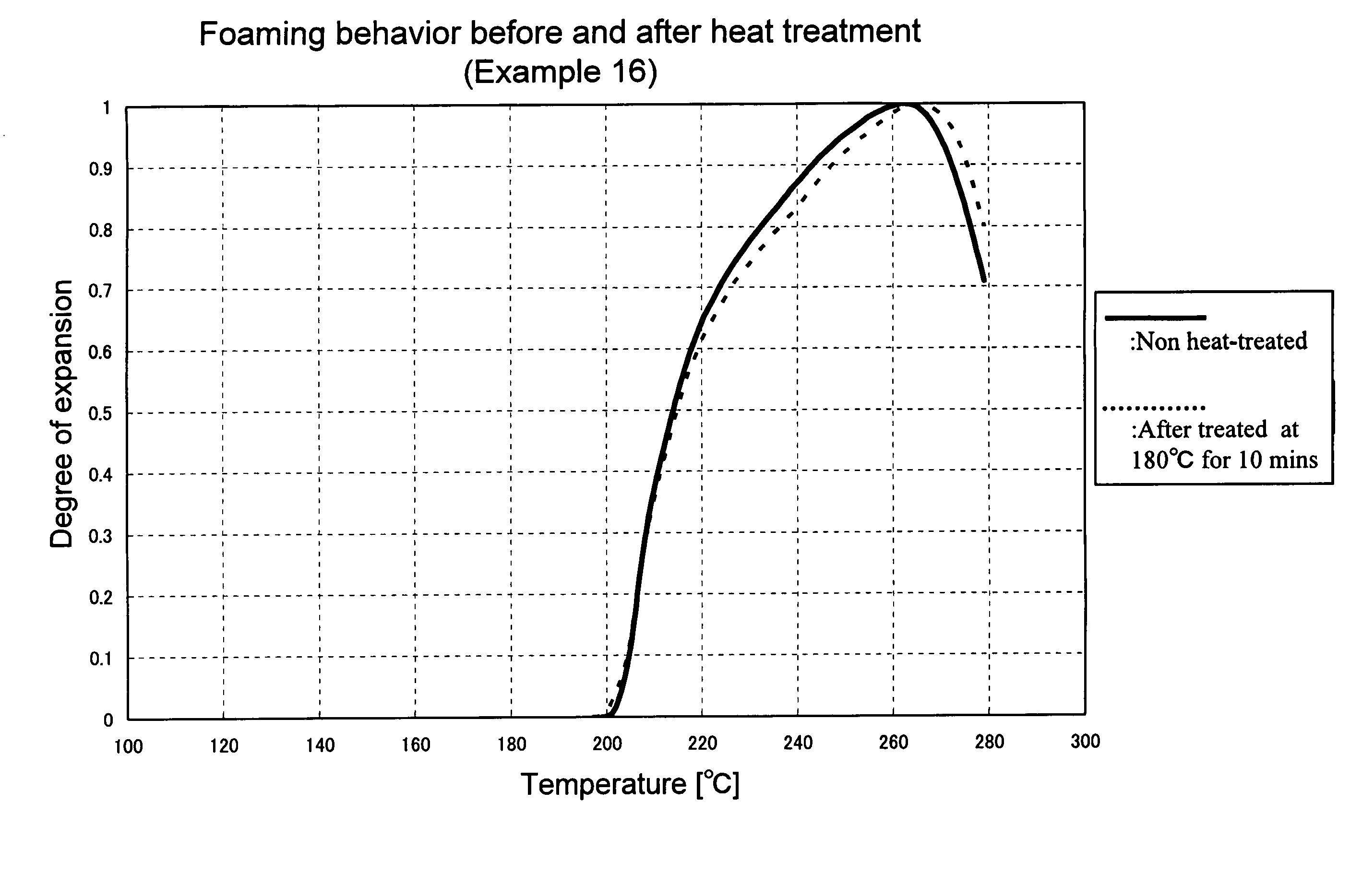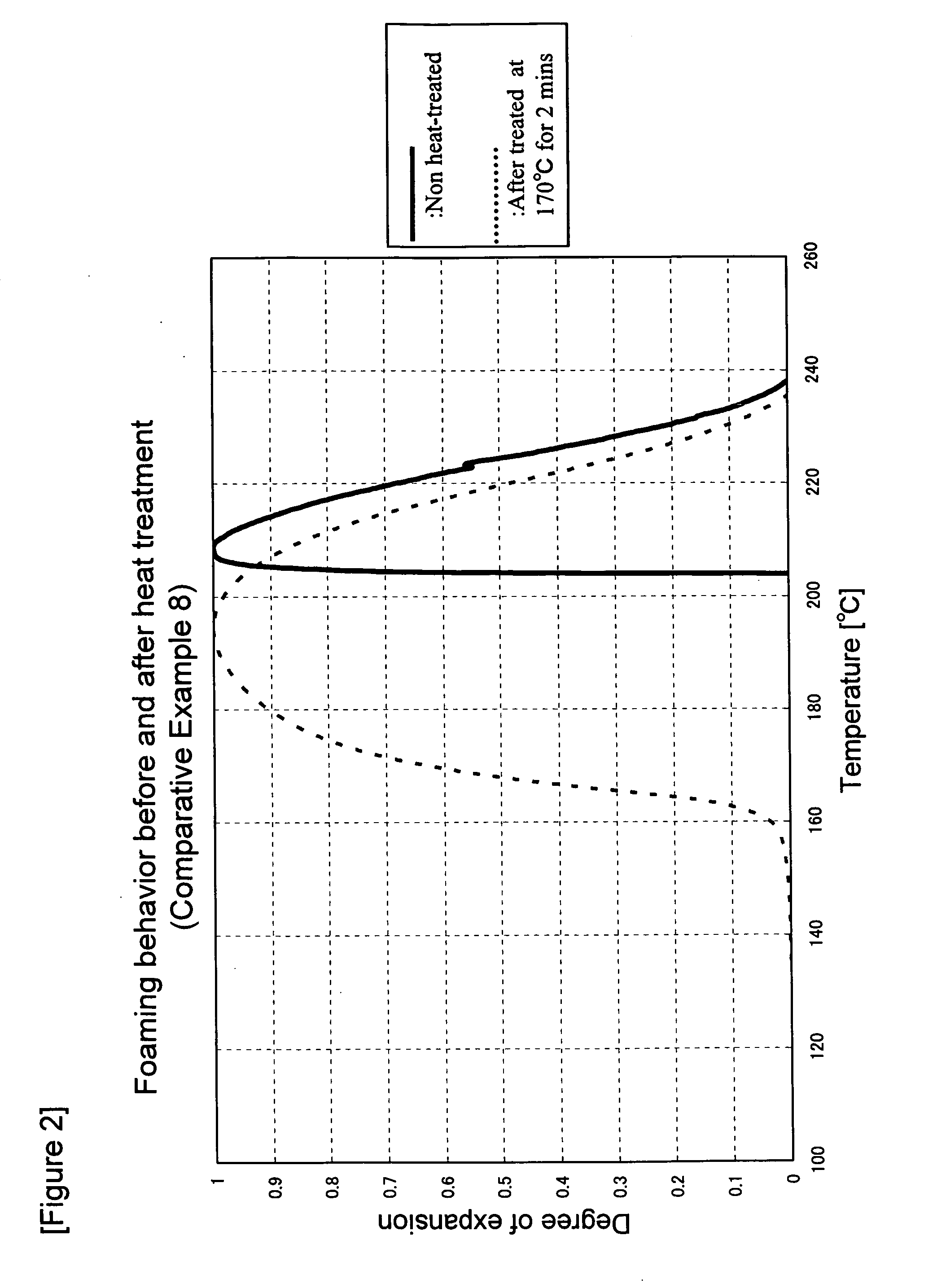Thermally Foamable Microsphere, Method of Producing the Same, and Use Thereof
- Summary
- Abstract
- Description
- Claims
- Application Information
AI Technical Summary
Benefits of technology
Problems solved by technology
Method used
Image
Examples
example 1
(A) Preparation of Aqueous Dispersion Medium
[0069]40 g of 20% by weight colloidal silica, 1.6 g of 50% by weight diethanolamine-adipic acid condensation product (Acid value=78 mgKOH / g), 0.12 g of sodium nitrite, 177 g of sodium chloride, and 565 g of water were mixed. Then, hydrochloric acid was added so that the pH was adjusted to 3.2 to thereby prepare an aqueous dispersion medium.
(B) Preparation of Polymerizable Mixture
[0070]88 g of methacrylonitrile, which is a polymerization monomer (indicated as MAN in Tables), 112 g of methacrylic acid (similarly indicated as MAA in Tables), 60 g of isooctane as a foaming agent, and 2 g of 2,2′-azobisisobutyronitril (similarly indicated as V-60 in Tables) as a polymerization initiator were mixed to prepare a polymerizable mixture. In Example 1, the molar ratio of methacrylonitrile to methacrylic acid was 1:1 (see Table 1).
[0071]The aqueous dispersion medium and the polymerizable mixture prepared above were mixed b...
example 2
[0074]Suspension polymerization was performed in the same manner with Example 1 except using 110 g of methacrylonitrile and 90 g of methacrylic acid to thereby obtain a thermally foamable microsphere with an average particle diameter of 39 μm. In Example 2, the molar ratio of methacrylonitrile to methacrylic acid was 1.6:1.
[0075]The TMA measurement was performed using, as a sample, the thermally foamable microsphere obtained as a result of the above manner as it was. As a result, the expanding starting temperature was 186° C., the maximum expansion temperature was 214° C., and the difference therebetween was 28° C. The expansion ratio was 8.4 times at 230° C. and the b* value was 26.8.
example 3
[0076]Suspension polymerization was performed in the same manner with Example 1 except using 132 g of methacrylonitrile and 68 g of methacrylic acid to thereby obtain a thermally foamable microsphere with an average particle diameter of 41 μm. In Example 3, the molar ratio of methacrylonitrile to methacrylic acid was 2.5:1.
[0077]The TMA measurement was performed using, as a sample, the thermally foamable microsphere obtained as a result of the above manner as it was. As a result, the expanding starting temperature was 171° C., the maximum expansion temperature was 255° C., and the difference therebetween was 84° C. The expansion ratio was 10.5 times at 220° C. and the b* value was 27.1.
PUM
| Property | Measurement | Unit |
|---|---|---|
| Temperature | aaaaa | aaaaa |
| Fraction | aaaaa | aaaaa |
| Percent by mass | aaaaa | aaaaa |
Abstract
Description
Claims
Application Information
 Login to View More
Login to View More - R&D
- Intellectual Property
- Life Sciences
- Materials
- Tech Scout
- Unparalleled Data Quality
- Higher Quality Content
- 60% Fewer Hallucinations
Browse by: Latest US Patents, China's latest patents, Technical Efficacy Thesaurus, Application Domain, Technology Topic, Popular Technical Reports.
© 2025 PatSnap. All rights reserved.Legal|Privacy policy|Modern Slavery Act Transparency Statement|Sitemap|About US| Contact US: help@patsnap.com



